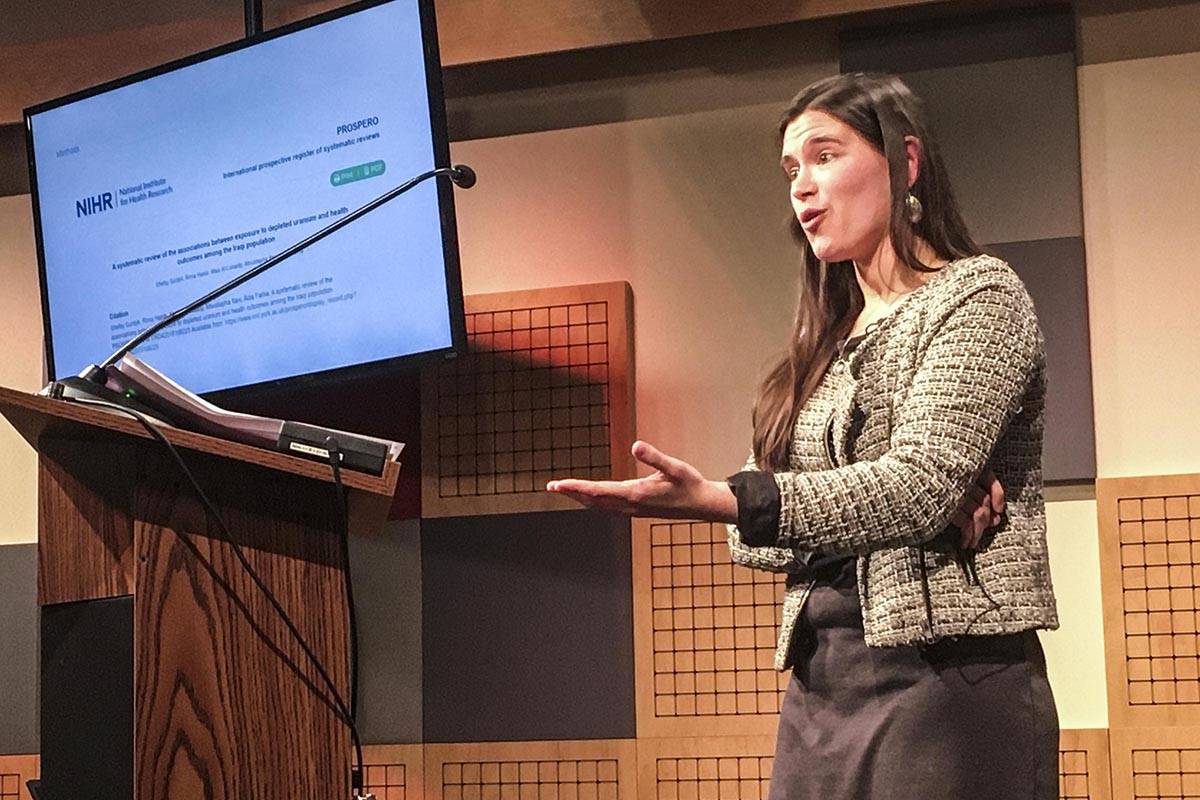Correction: This article has been updated to clarify several things that were incorrect or unclear. The U.S. government, not Surdyk’s teacher, studied the effects of radiation on the Marshellese without consent. Several statistics about enriched uranium and its creation were incorrect. The creation of aerosolized uranium, as well the statistics about its use, have been explained more accurately below. The title of Surdyk’s thesis has also been corrected.
The Marshall Islands are a long way from southern Iraq, but a poisonous legacy connects the two: a history of radioactivity that haunts both places.
“Beginning in 1990s, doctors in southern Iraq observed high rates of congenital birth defects in kids born in the region,” said Shelby Surdyk, a Skagway native, during a presentation on the public health effects of depleted uranium rounds in Iraq from Operation Iraqi Freedom on Thursday. “My interest in the health impacts of radiation began much earlier.”
Surdyk’s interest in the health impacts of radioactivity came from a high school teacher who had worked on Kwajalein in the Marshall Islands. The Marshall Islands were used as nuclear test sites in the 1940s and 1950s by the U.S. government, Surdyk said. The U.S. government also studied the effects of radioactivity on the islanders without their knowledge or consent. That teacher encouraged Surdyk and her classmates to present a play about the nuclear testing and the people of the island.
From there, Surdyk kept an interest in the public health effects of radiation. Surdyk said she heard about babies in southern Iraq displaying the same birth defects as children born in the Marshall Islands; children born without bones, without limbs, with translucent skin, nicknamed “jellyfish babies” for their appearance.
“Although the data suggest that there is a connection between uranium and adverse health outcomes in Iraq, the data is uncertain,” Surdyk said. “We didn’t find the condemning evidence that I’d hoped for, mostly because of the high risk of bias.”
Depleted uranium ammunition
Uranium is the 92nd element in the periodic table. It’s both dense, meaning it’s very heavy, and radioactive, which means it emits energy that’s harmful to humans. Enriched uranium has a higher concentration of the isotope U-235 and is used in nuclear reactors or nuclear weapons. Uranium that isn’t enriched is called depleted uranium, has a much lower concentration of U-235 than natural uranium, and emits far less radioactivity than natural or enriched uranium.
This makes it useless for nuclear weapons or reactors, but it’s still an ultra-dense metal, denser than tungsten. This makes it perfect for anti-tank munitions, like the 120mm sabot rounds or 30mm cannon rounds fired by U.S. tanks or anti-tank aircraft, which need that extra mass to penetrate and kill heavily armored targets. Conversely, depleted uranium also makes for good armor for those same tanks.
“It’s one of the densest materials known to man,” Surdyk said. “For all those reasons, including its abundance and low price, the U.S. began experimenting with it.”
The United States is one of several countries to use depleted uranium rounds. Russia, France, China and the United Kingdom are also known to use it. While data exists on its use in Iraq and the Balkans, Surdyk said, the statistics and locations for its use in Afghanistan, Syria and elsewhere are unverified.
“When depleted uranium munitions hit a hard target like a tank, they create a uranium oxide aerosols,” Surdyk said, meaning that some of the uranium is released into the air. “Most of the uranium that’s absorbed in the body is excreted in urine in 24 hours. But 10% remains.”
That same aerosolized uranium that’s in the air can also leech into the water table, Surdyk said. It’s small enough to cross the placental barrier, poisoning the fetuses rendering them into the limbless, skinless stillbirths that also plagued women in the Marshall Islands.
Laying ghosts to rest
With a background in Arabic from her study at University of Alaska Fairbanks, Surdyk applied for and was accepted for a master’s program at the American University of Beirut, studying environmental health. Her thesis was titled “A systematic review of the associations between exposure to weaponized
uranium and adverse health outcomes among the Iraqi population.”
Surdyk said she systematically reviewed dozens of articles and studies, correlating data of health issues across Iraq with areas with high reported rates of use of depleted uranium munitions, particularly Baghdad, Basra, Ramadi and Fallujah. But after defending her thesis, Surdyk said she wanted to do more.
“I felt like I was participating in the production of knowledge, but I wasn’t affecting change. I wanted to do something positive, make some change,” Surdyk said. “I was feeling pretty frustrated on how unengaged academia can feel.”
Surdyk returned to Alaska, taking a fellowship with the local chapter of the advocacy group Veterans for Peace, helping to organize an April conference for the Alaska Youth Congress for the Elimination of Nuclear Weapons, which will host students from nuclear-affected countries, including the Marshall Islands. The conference is named Point Hope, after the Alaskan community that successfully protested a plan to use half a dozen nuclear warheads to blast open a deepwater harbor on the North Slope in 1958.
“I don’t think that I can walk away from nuclear activism,” Surdyk said. “Even though it can feel remote to be here in Alaska, I think Alaskans can still have a powerful voice on the national and international stage and it’s important that young people know that.”
• Contact reporter Michael S. Lockett at 757-621-1197 or mlockett@juneauempire.com.

